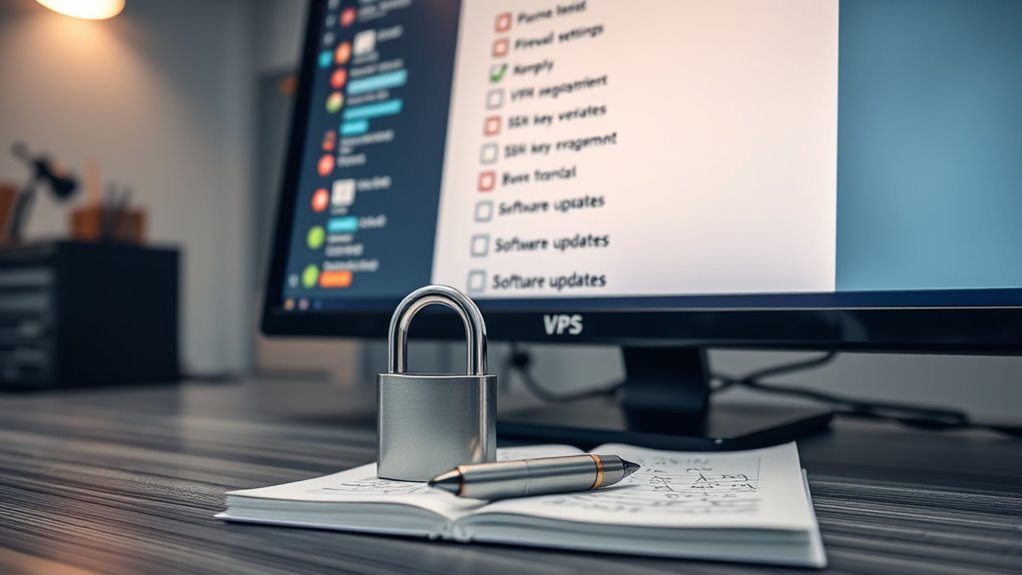To secure your VPS today, start by monitoring network traffic and quarantine unusual activity. Review user access and remove unnecessary accounts, enforcing strong passwords and multi-factor authentication. Confirm server configurations are up-to-date, disabling root login over SSH and using non-standard ports. Apply all security patches promptly and run vulnerability scans. Continuously check logs for suspicious patterns and stay vigilant through regular audits. Keep your security measures current—continue exploring for more expert strategies.
Key Takeaways
- Verify that all server software and OS are updated with the latest security patches.
- Review user access permissions and disable any unnecessary or inactive accounts.
- Ensure network monitoring tools are active and logs are regularly analyzed for suspicious activity.
- Confirm SSH configurations are secure, including disabling root login and using key-based authentication.
- Check firewall rules and port settings to restrict unauthorized access and minimize attack surfaces.

Securing your Virtual Private Server (VPS) is essential to protect your data and maintain reliable service. One of the first steps you should take is verifying your network monitoring setup. Effective network monitoring allows you to keep a close eye on your VPS’s traffic, spotting unusual activity or potential threats early. Regularly review your logs for any signs of unauthorized access or suspicious patterns. This proactive approach helps you identify vulnerabilities before they escalate into security breaches. Ensure your monitoring tools are configured correctly and cover all critical points of your network, including inbound and outbound traffic. By continuously monitoring your network, you stay informed and can respond swiftly to any anomalies, minimizing downtime and data loss.
Regularly review your network monitoring setup to detect threats early and protect your VPS from security breaches.
Next, you need to tighten your user access controls. Your VPS’s security depends heavily on who can access it and how. Review your user accounts frequently and remove any that are no longer necessary. Use strong, unique passwords for each account, and enable multi-factor authentication wherever possible. Limiting user access to only what’s essential reduces the risk of accidental or malicious breaches. Implement role-based access controls so that users only have permissions necessary for their tasks. This way, even if one account gets compromised, the potential damage is contained. Regularly updating your access list and credentials keeps your system resilient against unauthorized intrusions.
Additionally, consider setting up SSH key authentication instead of relying solely on passwords. SSH keys are far more secure, making it considerably harder for attackers to gain access through brute-force attacks. Make sure your SSH configuration disables root login and uses non-standard ports to add layers of obfuscation. Always keep your server software, including the operating system and security patches, up to date. Outdated software can have vulnerabilities that hackers exploit, so regular updates are non-negotiable.
Furthermore, understanding the importance of essential oils for digital security can serve as a metaphor for the layered approach needed in cybersecurity—multiple defenses work together to protect your system more effectively.
Finally, establish a routine for reviewing your security measures. Check your network monitoring tools to ensure they’re functioning properly, and verify that user access controls are up-to-date. Conduct periodic security audits and testing to identify weaknesses before malicious actors do. By staying vigilant and actively managing your network monitoring and user access, you considerably reduce the risk of data breaches, unauthorized access, and service interruptions. Remember, securing your VPS isn’t a one-time task; it’s an ongoing process that requires attention and discipline.
Frequently Asked Questions
How Often Should I Update My VPS Security Protocols?
You should update your VPS security protocols regularly to guarantee timely security. Typically, it’s best to review and revise them at least once a month, especially when new threats emerge or software updates are available. Staying proactive helps you patch vulnerabilities and adapt to evolving risks. Don’t wait for a breach—frequent protocol updates keep your VPS protected and maintain your peace of mind.
What Are the Best Tools for VPS Intrusion Detection?
When choosing tools for VPS intrusion detection, you should focus on solutions that help you monitor firewall configurations and analyze logs effectively. Tools like Snort or Suricata detect suspicious activities by analyzing network traffic, while Fail2Ban helps block malicious login attempts. Regular log analysis with these tools alerts you to potential breaches and keeps your VPS secure. Combining these methods guarantees thorough protection against intrusions.
How Can I Secure My VPS Against DDOS Attacks?
Like a modern-day fortress, you can guard your VPS against DDoS attacks by configuring your firewall effectively, blocking malicious traffic before it reaches your server. Regular malware scanning helps detect and eliminate hidden threats that could be exploited during an attack. Combining these strategies, along with rate limiting and using a content delivery network (CDN), guarantees your VPS stays resilient, even amidst the chaos of a digital siege.
Is Two-Factor Authentication Necessary for VPS Access?
You should definitely enable multi-factor authentication for your VPS access, as it adds an extra layer of security beyond just a password. This helps prevent unauthorized login attempts, especially if your password gets compromised. Pairing MFA with VPN encryption further secures your connection, ensuring that only authorized users can access your VPS securely. Together, these measures substantially reduce your risk of unauthorized access and potential breaches.
What Are Common VPS Security Vulnerabilities to Watch For?
Did you know that over 60% of VPS breaches stem from weak security practices? To protect your VPS, watch out for common vulnerabilities like poor password management and misconfigured firewalls. Regularly update passwords, enable two-factor authentication, and review firewall rules. Keeping these aspects secure diminishes your risk of unauthorized access, data leaks, and cyberattacks. Stay vigilant and proactive to ensure your VPS remains safe from evolving threats.
Conclusion
By following this VPS security checklist today, you’re proactively safeguarding your data and peace of mind. Think of it as locking every door and window before leaving—sure, it takes a moment, but it’s worth avoiding costly breaches later. Don’t assume your VPS isn’t a target; cyber threats are always lurking. Take action now, and imagine the relief of knowing you’ve done everything possible to keep your server safe from harm.








